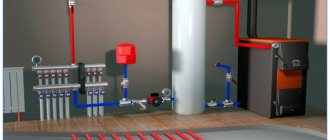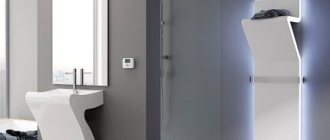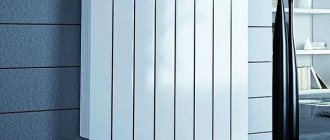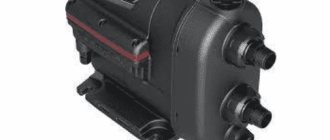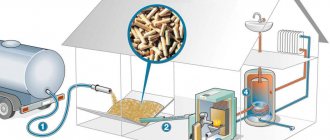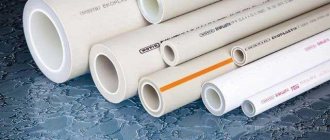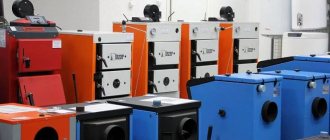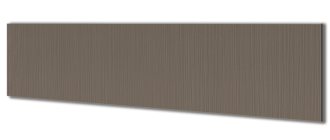Modern heating systems are equipped with a variety of equipment, which significantly increases the efficiency of heat transfer. The main trend of our time remains water heating convectors, which have a high efficiency, affordable price and stylish design. The listed advantages are enough to choose this option.
Efficiency is a “fat” advantage of this heating
What is the principle of convection
Convection heating is based on the application of the simplest physical laws - according to them, warm air becomes lighter and for this reason it begins to rise. In accordance with this principle, each convector battery operates, regardless of its power source.
As practice has shown, this heating scheme is characterized by efficiency and the rooms become comfortable relatively quickly. Convector heating provides heating of premises for various purposes, including covered loggias and balconies. Heating is carried out by heated air, which quickly saturates the home with heat.
The heating process occurs as follows:
- The heating element of a convector-type battery has a large working surface area and is capable of warming the air around it.
- After this, the air masses leave the equipment and rush upward.
- Their place is taken by cold air currents.
- This sequence continues until the heating system has completely warmed the room.
Heating elements can operate from an electrical outlet and through the use of gaseous fuel. Convection heating radiators operate due to the supply of hot coolant. They do not have housings, unlike gas and electric convectors. But the principle of their operation is similar - heating occurs due to heated air, and their thermal radiation is minimal.
We calculate energy costs
Now we will try to calculate the power of the equipment necessary to heat the rooms. In our calculations we will use the standard formula, based on which for heating 1 sq. m we need 100 W of thermal energy . In the northern regions, this figure increases to 150 W, and in the southern regions it drops to 80 (it is best to focus on 100 W or check this figure with heating specialists in your region).
Remember a simple rule for calculating the power of a convector: multiplying the area of the room by 100 you get the power required for heating it in W.
Let's say we need to heat a house measuring 50 square meters. m of living space. For this we will need electric convectors with a total power of 5 kW. If the devices operate around the clock, the daily consumption will be 120 kW. Based on the average cost of 1 kW of energy at 4 rubles (different in different regions), daily costs will be 480 rubles, and monthly costs will be 14,880 rubles (for months with 31 days).
But convectors do not operate around the clock - they periodically turn on and off, maintaining the set temperature . Therefore, we can safely reduce the amount received by half - it will be 7,440 rubles. You also need to take into account that winters can be warm, with a large number of days with positive temperatures. In this case, heating costs will be lower. Electronic control, which provides more accurate support for the set temperature, will also help reduce costs.
Pros and cons of convector heating
The main advantages of this type of home heating:
- It is possible to heat rooms for a variety of purposes.
- There is no adverse effect on the air condition, since convector heating does not burn oxygen.
- Minimal impact on air humidity.
- Easy installation of heating equipment - this plus applies to electrical units.
- There is no negative impact on people's well-being.
- A wide range of equipment for the arrangement of heat supply.
In addition to the advantages, convector heating has disadvantages:
- The feeling of overheated air, which not all residents like.
- If the room has high ceilings, this type of heating will be ineffective.
- There is a big difference between the temperature in the upper layers of air and those located below.
As for electric convector heating, it has another big drawback - high cost. But not all houses have a gas main, and if there is a desire for the heat supply system to not require large expenses and be easy to install, then in this case it will not be possible to do without convectors.
In country houses with a small area, the best solution would be to install electric convector heating, since it will be possible to save on laying the pipeline and installing a heating unit.
Maximum operating temperature
| Parameter | Radiator Rifar Monolit | Convector TS CARNOT |
| Maximum operating temperature | 135°С | 110°C |
The radiator can handle higher temperatures. However, the question again arises - why? The maximum temperature circulating in the system in the most severe winter is 90 degrees. But let’s be honest, city utilities have not provided this temperature for a long time. The maximum is 80 degrees.
In new houses, this figure often does not even reach 60 degrees, and people are freezing due to the fault of management companies and operating organizations.
Types of systems using convectors
A heating system based on the convection principle can be:
- water - using convection radiators, pipes and an electric, gas, solid fuel or liquid boiler;
- electric – implies the installation of electric convectors;
- gas - in this case, gas convectors are installed in the premises, which usually operate from bottled gas.
All of the above heat supply systems have distinctive characteristics.
Price
| Parameter | Radiator Rifar Monolit | Convector TS CARNOT |
| Price | RUB 11,480 | RUB 21,380 |
| Cost of fasteners | 280 rub. | included |
The price difference is 9,620 rubles in favor of the radiator. Therefore, if the goal is maximum savings, a radiator, without a doubt, will be a suitable solution to the heating problem.
Wooden convector hidden in the floor, TS CARNOT
However, if a modern, beautiful and safe heating method is important to you, the choice is yours! In the following articles, we will talk in detail about the various models of convectors and methods for selecting them.
Convector heating batteries
Many property owners prefer classic options for arranging heating in their own home or apartment. They lay pipelines, install a heating unit and a convector heating battery in the required quantity. A big advantage is the presence of a gas pipeline in the house, since this type of heating using a gas boiler is inexpensive and effective.
Heating based on equipment operating on liquefied gas is also economical. The next most economical ones are boilers operating on solid fuels. Heating using them will be free if there is a forest near the country house in which you can prepare firewood on the eve of winter. When it is not possible to chop logs, then it is better to purchase fuel in bulk, which will be much cheaper.
In this case, water heat supply involves the installation of convectors - heating radiators, which must be connected to a pipeline laid throughout the premises of the house. The heated coolant, after entering the batteries, heats up the metal surfaces, and then the heat is transferred to the surrounding air space.
Warm air rushes towards the ceiling, and cold air currents take its place. Temperature control in water systems is carried out using a boiler or taps and valves located on the batteries. Quite often, wall-mounted water heating convectors are installed, which are efficient and economical.
Taking into account the complexity of installation, the arrangement of such a heat supply option is considered optimal for buildings with a large number of rooms, since from a financial point of view, the installation of a large number of autonomously functioning electric convectors cannot be called justified.
Experts also recommend using water convector heating in houses connected to gas supply lines and for those property owners who have access to inexpensive types of solid fuel.
Device safety
When choosing a floor-standing electric convector, make sure that it has tip-over protection.
When purchasing convectors for a private home, you need to make sure that the following security systems are available:
- rollover protection – will turn off the heating if the convector accidentally falls (relevant for floor-standing models) ;
- overheating protection – ensures the safety of equipment when the critical temperature is exceeded;
- protection against moisture - relevant for convector heaters that will be used in wet rooms, for example, in bathrooms.
Using our recommendations, you can buy excellent electric convectors for heating a private home.
Electric convectors
Setting up convector heating using electric convectors is easy.
The installation process is as follows:
- Brackets are attached to the wall of the room.
- Convectors are hung on them.
- Heating devices are connected to the power supply.
If you need to heat a small country house with only one room, the installation work will take no more than half an hour. In this case, it will be more difficult to run the wires to the outlet than to hang the device. This type of convectors runs on electricity.
Unlike the convector-type heating radiators described above, they do not contain coolant or other types of liquid. Heating occurs due to the presence of ribbed heating elements. They are located at the bottom of the devices. Air is taken in through the lower slots and discharged through the upper openings.
The operation of convector equipment is monitored by automation, which can be mechanical or electronic. The first type of thermostat operates on the principle of a bimetallic plate. After the temperature reaches a predetermined value, the plate begins to bend and opens the contact group.
When the air cools, the opposite effect occurs - the contacts open and the heater continues to operate. It is not the temperature that is set on it, but the degree of heating in numbers.
Electronic thermostats are controlled by modules with sensors, a microcircuit and other electronics. These devices control the air temperature by sending a signal to turn the heating elements on/off.
This scheme has the following advantages:
- Convectors have additional functionality due to the presence of a timer, anti-freeze, operation in accordance with a given program, etc.
- Economical - electric convectors save energy by 5 - 10%.
- It is possible to adjust the temperature up to 1 degree.
Taking into account these advantages, it is best to create convector heating based on automatic devices. They are more expensive, but the heating efficiency has a big advantage.
This heating method is usually used to supply heat to non-gasified houses of medium and small size. Its main disadvantage is that you have to pay a significant amount of money to heat a small house.
Features of choice
Before purchasing equipment, you should pay attention to a number of nuances:
- Calculate the installation area, determine the dimensions of the battery.
- Radiators with moisture-resistant housings are suitable for installation in areas with high humidity. And if an in-floor convector is built into the bathroom, it is necessary to equip a drainage system.
- Select the type of unit for air circulation. The use of fans increases noise during operation, the devices raise dust and will require the installation of a power supply, but they will warm up the room much faster.
- The pressure for central systems is within 8-9.5 atmospheres, in autonomous systems no higher than 3 bar - these parameters are taken into account when choosing products. Moreover, some types of equipment support 10 bar working pressure and 16-20 bar testing pressure.
- The number of pipes and the dimensions of the radiator determine the volume of coolant. The average is considered to be 0.7-2 liters.
- The weight of the equipment is calculated only together with the coolant and can be 14-24 kg. This is an important parameter for mounted products.
- The heating limit of the filler is +130 C, but to prevent burns, heating the body no more than +60 C is suitable.
Advice! When choosing convection batteries, it would be a good idea to look at the presence of an automatic control and monitoring system. A control valve and thermostat will allow you to determine the mode and maintain it for a specified time.
How to calculate power?
Thermal power is calculated by the formula - 1 kW of heat is needed for 10 m2 of area. This is an average figure for houses with high-quality insulation without large windows, in regions with mild winters. A point discrepancy implies a 5-10% increase in power. So, for houses with insulating materials of insufficient thickness, units with a calculated power parameter of plus 15% are suitable; in regions with harsh winters, the reserve will have to be increased by 35-40%. Another 200 W is added for each panoramic window.
Gas heating convectors for home and their design
Review of manufacturers
Well-proven brands of appliances with natural convection:
- Carrera S. Dimensions 230x1000x90 mm, heat output 260 W, price from $170 (10,800 rubles).
- Verano VK15 of similar sizes with an energy output of 188 W costs from $210 (13,400 rubles).
- Polvax KE with dimensions of 230x1000x90 mm with a heat output of 258 W is considered the optimal choice for small buildings. Price from $170 (RUB 10,800).
Forced convection equipment:
- Polvax device dimensions 300x1000x90 mm, heat output 1127 W, price $260 (17,000 rubles).
- A Carrera device of similar dimensions with a heat output of 904 W will cost $260 (17,000 rubles).
- Kermi brand equipment with dimensions of 310x1250x110 mm and a power of 1722 W can be purchased for $1,100 (RUB 71,500). The equipment has different displacements, additional equipment for setting operating modes, and maintains any heating level for a long time.
On a note! The Kermi brand are expensive devices made of ceramics or copper-aluminum alloys, which have the highest heating rates, are practical to use, and resistant to mechanical damage.
Suitable Models
Electric convectors for home heating from the NOBO company and control of all possible electrical appliances within the facility, as well as from anywhere in the world, via SMS commands (Orion 700+GSM) or via the Internet (Energy control) is the best option.
For wooden houses, heaters of the Viking series (C2F - C4F and C2N - C4N) with a side exit of hot air into the room are more often used. The body of such convectors heats up slightly and therefore burns from contact or, moreover, fire of nearby objects is completely excluded.
In Oslo series convectors, hot air from the convector comes out upward, so it is advisable to install them under windows or on walls that border with outside air. The body of the convectors of this series, like that of Viking, does not heat up to very high temperatures, and therefore cannot cause burns or fire.
Oslo convectors have removable thermostats to regulate and maintain the air temperature in the room; there are also manually controlled thermostats or more complex ones with the possibility of remote control via the Internet or SMS commands.
Review of manufacturers
A convector battery, the price of which depends on many factors, can cost in the range from 2 to 20 thousand rubles. The simplest types of electric batteries have a minimal set of functions. Their cost is from 2 thousand rubles. But among the variety of models presented, experts advise choosing electric convectors with TEN or monoblock. Devices from the Electrolux, Polaris, and Ensto brands have proven themselves well.
A gas convector will cost more. Its cost is from 13 thousand rubles. The most famous manufacturers of this type of equipment are Karma, ATON, Gorenje. Reviews about these manufacturers are more positive.
It should also be noted that the cost of the convector depends on the principle of its installation. Floor and wall models will cost much less than built-in equipment.

